No.60007
Keeping a main line steam locomotive running on the national network is no small feat, particularly in the heavily regulated world of 2025. So, how does the team managing one of the scene’s undisputed celebrities – ‘A4’ Sir Nigel Gresley – manage?
WORDS AND PICTURES: TREVOR CAMP (EXCEPT WHERE NOTED)
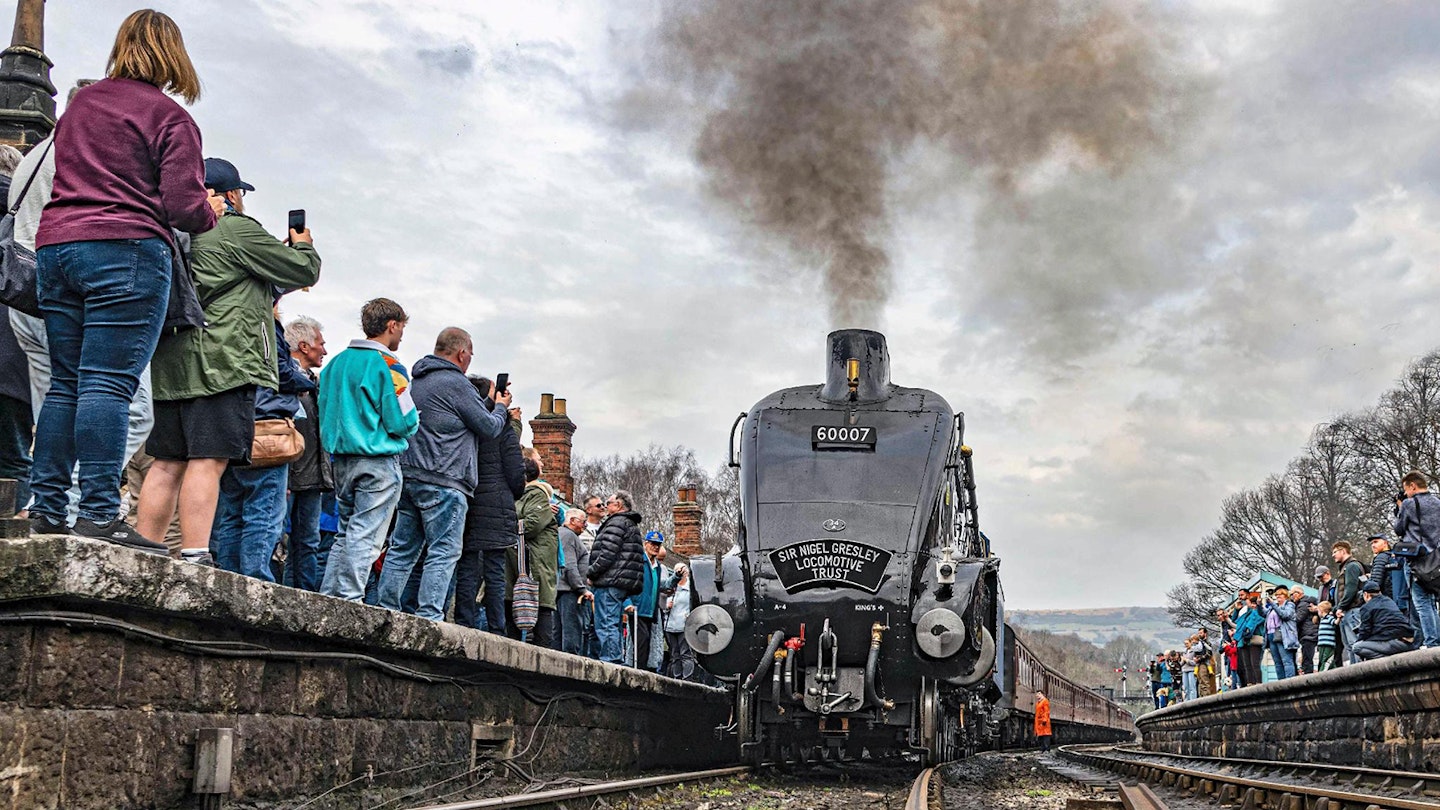
‘A4’ No. 60007 Sir Nigel Gresley attracts plenty of attention as it prepares to depart Grosmont on March 22, during its recent spell on the North Yorkshire Moors Railway. BRIAN HALL
It is 4.30am on a dark, chilly, damp and very misty morning as I join the westbound M62 and head up and over the Pennine hills of West Yorkshire. I need to drive 90 miles to Crewe by 7am to meet up with the Sir Nigel Gresley Locomotive Company (SNGLC) Locomotive Engineer, Darrin Crone, for whom these early starts are a way of life.
If everything went to plan, Locomotive Services Limited’s (LSL) own ‘A4’, No. 4464 Bittern, would have arrived overnight by road transporter from storage in Margate for the start of her overhaul back to operational main line working. LSL has entrusted this overhaul to the SNGLC engineering team after the team’s exceptional work in overhauling their own ‘A4’ locomotive, No. 60007 Sir Nigel Gresley. The boiler will be removed at Crewe for overhaul by LSL’s own boilersmiths and the rest of the locomotive would then be transported by road to LSL’s new North Yorkshire base, where she would be reunited with her tender which had gone there directly from Margate.
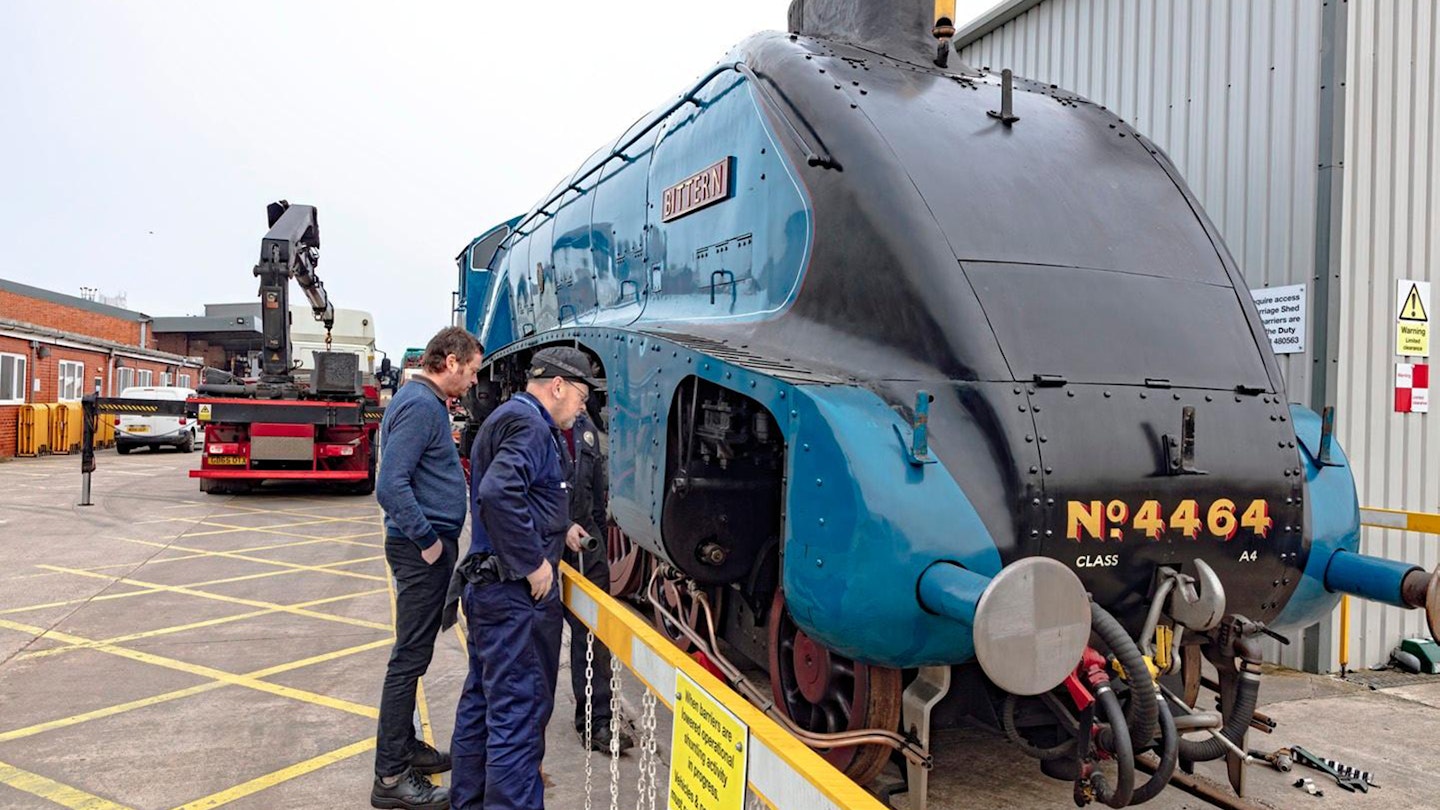
SNGLC Locomotive Engineer Darrin Crone (right) looks on as ‘A4’ No. 4464 Bittern is unloaded at LSL’s Crewe workshops on February 28, ahead of its long-awaited overhaul which will be managed jointly by LSL and the SNGLC.
Since the move from the National Railway Museum in York to LSL’s workshops in Crewe after Covid in 2020 to complete the overhaul of Sir Nigel Gresley, the working relationship between SNGLC and LSL has blossomed into a strong bond of mutual respect, which has benefited both teams. This bond was born early in the relationship, when LSL officials met Darrin at the NRM to discuss the future operational contract, and they saw first-hand the quality and exacting standards of Darrin and his team. This led to discussions about the Bittern overhaul starting long before No. 60007’s move from the NRM to Crewe, and was an early sign of the developing working relationship.
Darrin’s team’s knowledge, impeccable standards, professionalism, and ability led to LSL asking SNGLC to conduct the Bittern overhaul and, subsequently, suitable premises near Northallerton in North Yorkshire were acquired and fitted out. The 100% oreliability of ‘SNG’ throughout 2024 was a proud achievement for the team, and with the now increased workload of the two locomotives, Darrin wants to further strengthen the team with a salaried assistant engineer.
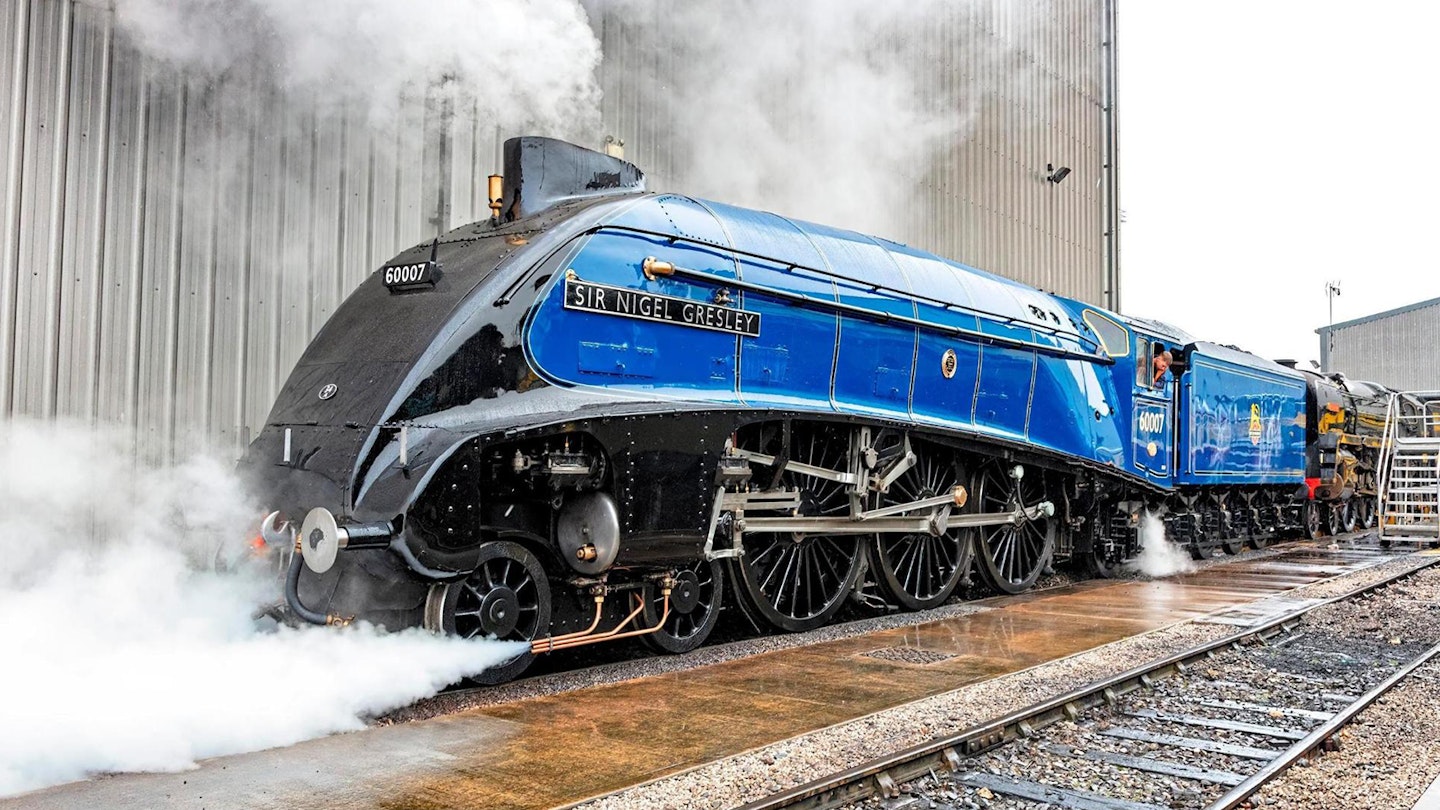
Recently repainted into its familiar BR express passenger blue livery, Sir Nigel Gresley undergoes a successful steam test at its new Crewe home on March 8 2023.
A railwayman’s oasis
Passing through the security gates at LSL’s Crewe locomotive depot, you are at once transported to a nostalgic period in railway history, with a Class 47 diesel engine idly ticking over, the rakes of immaculately turned-out coaches from the 194080s era, and a wonderful mix of steam, diesel and electric locomotives from an even wider range of years. There is an intoxicating aroma of railway smells that greets you as soon as you step out of the car, no doubt enhanced by the still, windless, misty atmosphere which is slowly changing minute by minute as night turns slowly into day. A railwayman’s oasis is a world away from the urban commute slowly emerging in the surrounding area, and a privileged moment to savour.
It is now 6.35am. Almost 30 minutes early, I’m wondering if Darrin is here yet, so I call him and the answer is, “Yes, I’m in the coach, where are you?” I reply, “Walking through the running shed.” “Really? I’ll put the kettle on. Is Bittern there yet?” “No, I can’t see her,” I disappointedly respond, and you cannot really hide a ten-wheeled trailer and tractor unit carrying 103 tons of locomotive in the car park (168 tons with tender). So, climbing into our support coach, I am met by Darrin with my cup of tea from the adapted kitchen in the guard’s area. We retire to the warmth of the oil-filled radiator comfort of the First Class compartment that is often Darrin’s second home, and lament over the missing locomotive.
After half an hour or so, we open the curtains to find the night has now turned into day and the floodlit scene is beginning to be replaced by long shadows of light and dark from the shafts of low sunlight piercing through the morning mist. Yes, as if by magic, Bittern has arrived! The huge transporter has completed its overnight trip and is being expertly reversed down the several hundreds of yards into position to unload its precious cargo. My job of photographically documenting the event and Darrin’s job of overseeing the unloading with LSL staff could now begin, and it is only 7.30am!
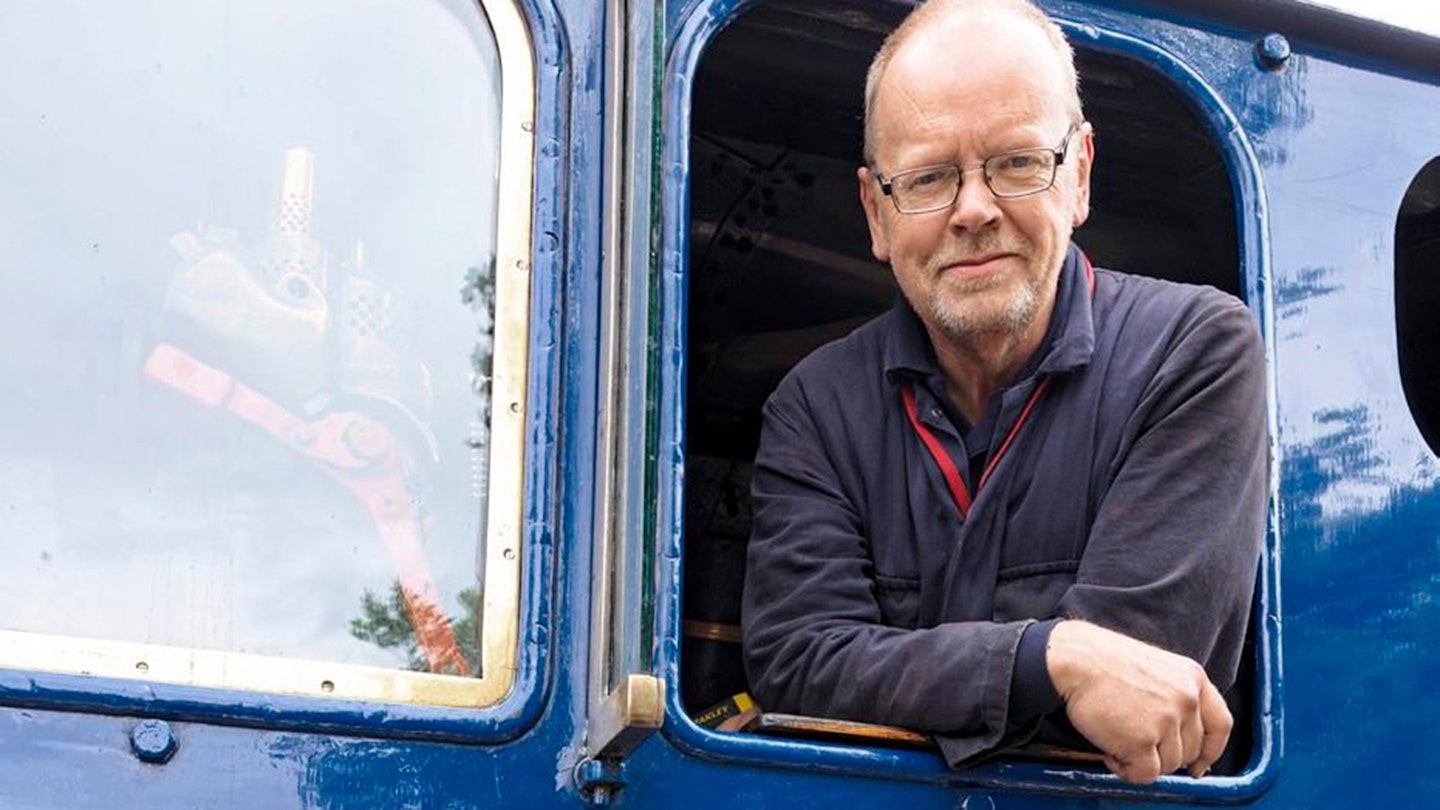
Darrin Crone leans from No. 60007’s cab.
Opportunity of a lifetime
A few weeks later, I get the chance for a longer chat with Darrin over a coffee, lemon drizzle cake and his beloved Jammie Dodgers. He freely admits he loves his work as he is being paid for doing what would be his hobby had he any other job. How good is that? Having spent 10 years watching him work at his hobby, I can also freely admit to knowing how good that is for him. It does all seem very glamorous, but it comes with a huge chunk of responsibility and commitment. He tells me a story from an incident on one main line trip when disaster was narrowly averted. About to collect several hundred passengers who have all spent several hundred pounds to ride on the main line behind ‘SNG’, he noticed the air pressure gauge for the coach braking system rising uncontrollably. A fix was required or the trip would be cancelled at the eleventh hour as no back-up steam locomotive was available. The compressed air system is a modern addition for the hostile environment of a 1937-built steam locomotive, and it was designed for the comparatively clean environment of a diesel locomotive. The control valve is underneath the cab floor above, over which coal is constantly being transferred from tender to firebox, so could it be coal dust in the valve? There’s only one way to check, and the clock is ticking. Run late and you risk a network fine, not to mention delaying main line services. So, Darrin and his support crew got a wrench and removed the cover to check. Staying calm and thinking logically, he finally breathed a huge sigh of relief as, at the second attempt, he found and removed an offending single speck of dust, which was enough to affect the valve seal, thus allowing the pressure to return to normal.
The mental demands and stress put the job way beyond being just a hobby. Staying calm under pressure is an absolute necessity; panicking is not an option. Even when being watched by the locomotive crew and traction inspector while looking at their watches.
This job is not for a railway enthusiast with engineering ability, but for an engineer with railway enthusiasm. Someone who knows his Whitworth from his metric, his left hand from his right hand, and can drill and tap out.
Darrin does have the support of volunteers: Richard Swales, who is CME (Chief Mechanical Engineer), Andy Barwick and Phil Gillespie, all of whom are qualified ‘Duty Engineers.’ Not forgetting the other volunteers, along with the excellent team at LSL. But the addition of a full-time assistant engineer is now a priority. Like Darrin, any assistant would have to be extremely flexible regarding hours worked and availability, as well as being comfortable in periods away from home when on tour and/or visiting heritage railways, as the accommodation is often a compartment in the support coach.
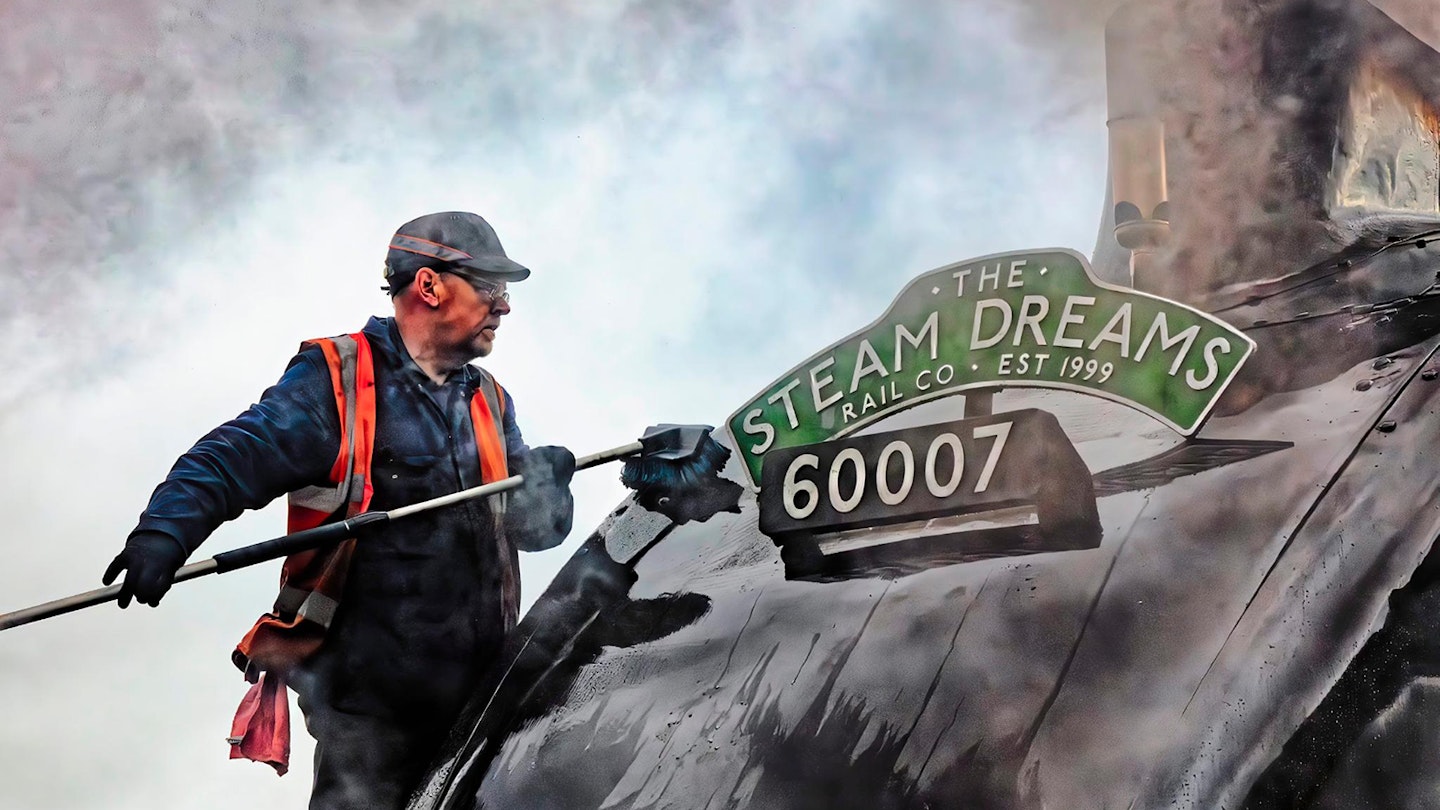
Darrin cleans No. 60007’s distinctive streamlined smokebox ahead of a Steam Dreams tour from York to Edinburgh on November 23 2023. Keeping the ‘A4’ fit aesthetically is just as important as looking after it mechanically.
Attention to detail
Darrin talks me through the long hours of a hypothetical operational railtour day. A departure from a London terminus would require relocation of the locomotive from the Crewe base (after the Fitness to Run – or FTR – assessment has been completed and signed off) at least the day before to the London LSL facility in Southall, necessitating an overnight stay after a probable late evening arrival followed by an early morning start around 5am. A comprehensive locomotive inspection and preparation – which includes oiling and cleaning, stoking the overnight warming fire to raise the boiler pressure to operational level, running and checking all the systems are working correctly – would then be required. Hopefully, everything goes to plan, so when the footplate crew of driver and fireman arrive, you are all set to go and collect the coaching stock on the timings of the distributed network pathway, so any last-minute problems need to be resolved quickly. You have a scheduled path to keep, not to mention a platform of fare-paying customers not to disappoint. You will stay for the duration of the trip, offering the footplate crew engineering support and being available as and when needed, particularly at all the water stops. The corridor tender of ‘Gresley’ comes in extremely useful here, offering the ability to move from the footplate to comfortable seats in the support coach.
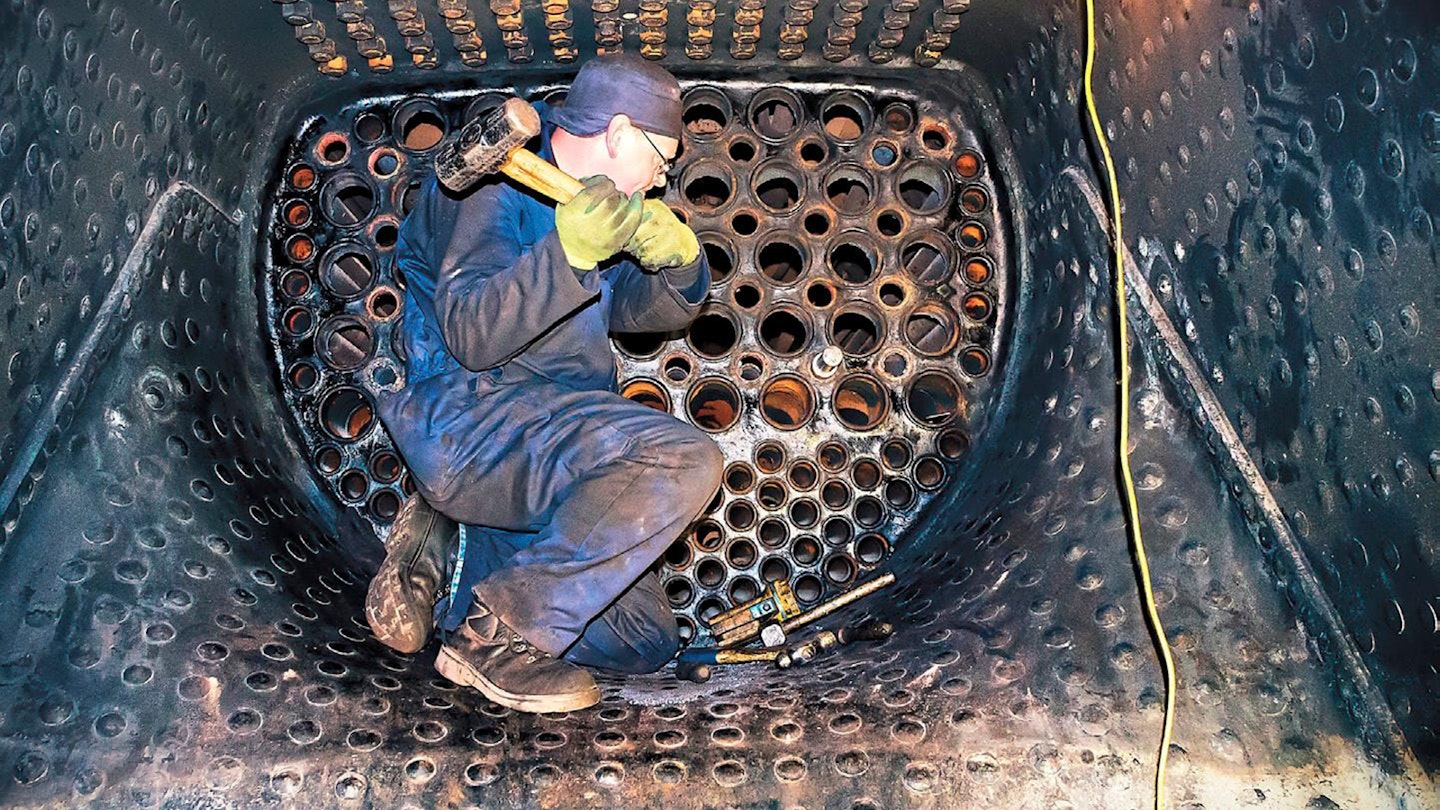
Darrin Crone gets his hands dirty inside Sir Nigel Gresley’s firebox in February 2016, while its overhaul was under way at the National Railway Museum in York.
It is an oasis of comparative calm, offering a chance for a cuppa and even a Jammie Dodger, or possibly a few minutes snoozing after the full-on, hectic earlier 24-or-so hours, even though you are always listening to the sound of the locomotive listening for anything out of the ordinary.
And so, the first half of your Duty Engineer shift has passed. All has gone well, so nothing much left to do except the whole thing again for the return journey. After an exceptionally long day, the passengers disembark at their final destination, but you are not finished just yet, as the locomotive needs to be returned to Southall and, ultimately, back to Crewe, depending on the schedules, which may require a longer stay away. This is anything but a regular job, but an incredibly special role which comes with huge responsibilities yet offers exceptional job satisfaction. If your circumstances allow you to make what can be a career-defining commitment – as Darrin did at the age of 50 when he felt his engineering career needed a fresh challenge – this could be your opportunity.
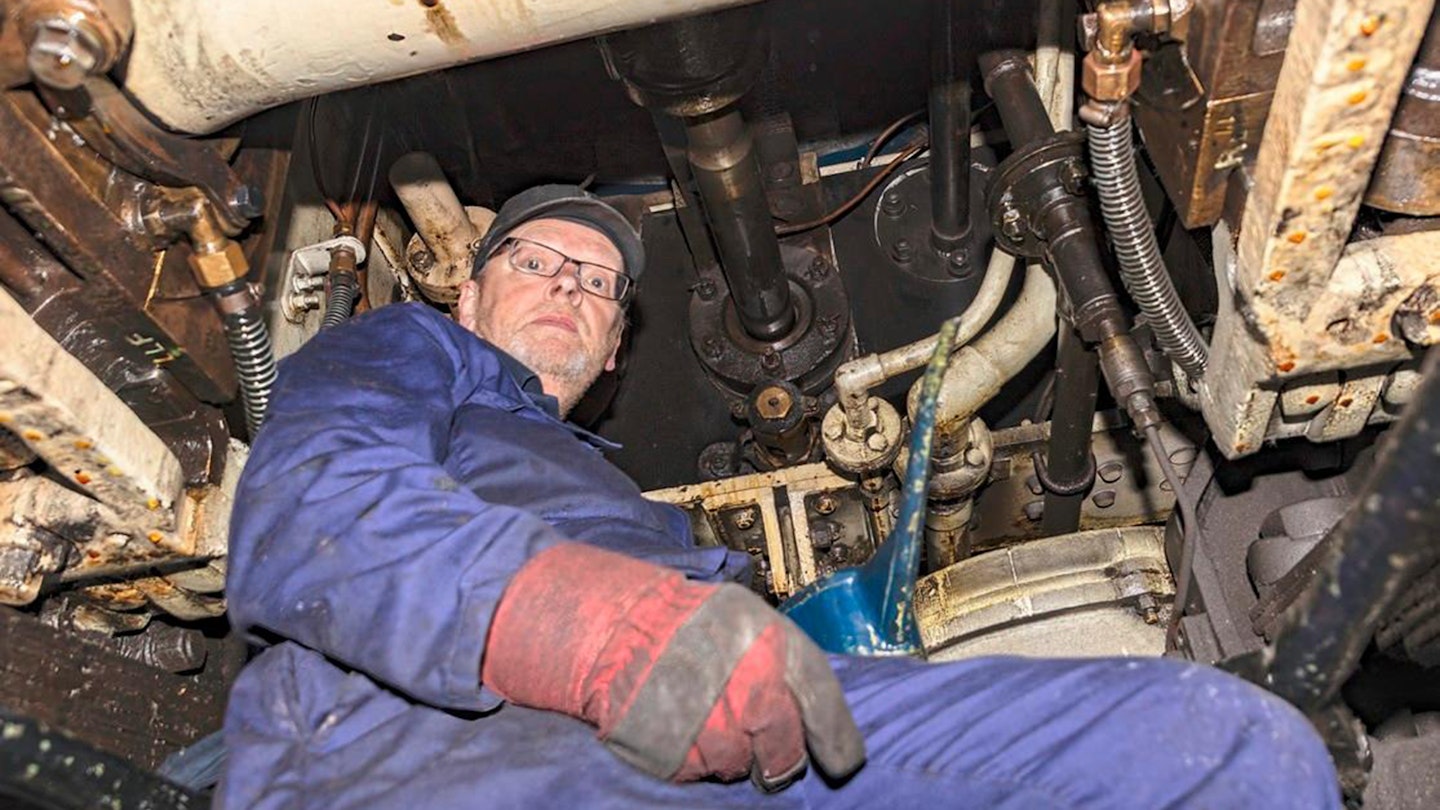
Darrin Crone climbs up underneath between the main driving wheels with an oil can to attend to one of Sir Nigel Gresley’s small ends at Crewe on May 12.
The days when people see ‘SNG’ in operation are sandwiched between many days of maintenance, preparation, testing and many auditable levels of certification/accreditation, including FTR. Darrin explains that the FTR test is a very demanding examination carried out by an independent examiner, and it is usually left until the day before a trip, so the clock is ticking if anything requires fixing. But he goes on to point out that you really can’t do an FTR any earlier, as the fire needs to be lit and the boiler brought up to pressure to carry out the test. Unlike a diesel or electric locomotive, where you can just switch it off, it would be expensive, time-consuming and simply not practical to do that with a steam engine. As important as it is, the FTR is just one of the many procedures that are routinely carried out to enable main line operations.
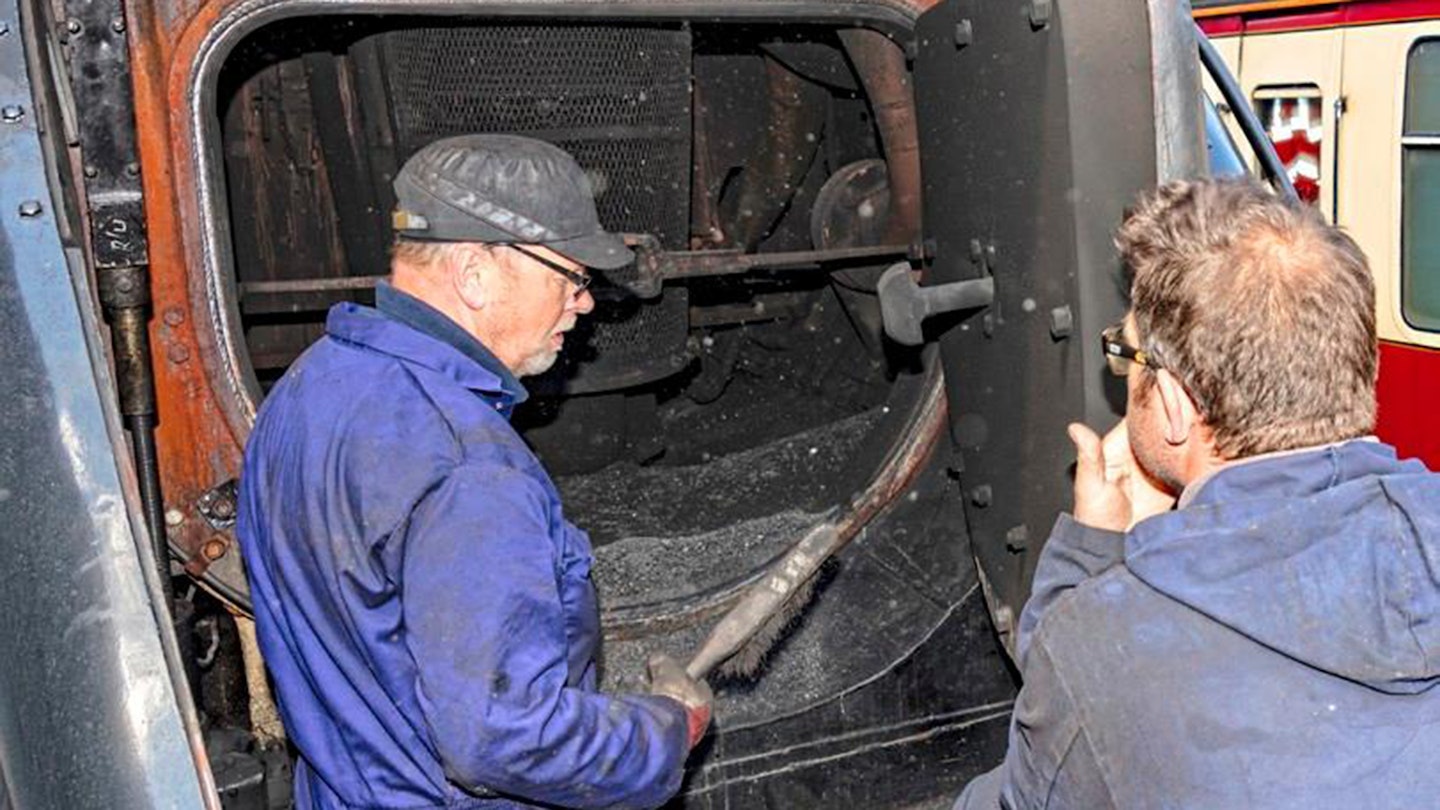
Darrin Crone, with the smokebox door open ready to be cleaned out of ashes, discusses future work with LSL’s Mark O’Brien.
There are many procedures that need to be undertaken and administered to follow operational fitness and safety. A major attribute, and a big part of Darrin’s job that goes on in the background unnoticed by the fare-paying passengers or the trackside enthusiasts, is administration involving the ability to work with the many other bodies involved, which is as important to the job as the hands-on tasks. Another often commented on factor is the excellent cosmetic condition Darrin absolutely insists ‘SNG’ is kept in by his team of volunteers, supervised by his own acute attention to detail. I can attest to this, having on occasions put my camera down only to find it quickly replaced with polish and cleaning rags. He sets the bar high in all aspects of looking after ‘SNG’, and this will undoubtedly not have gone unnoticed by LSL which will not for one minute expect anything different with Bittern. While it’s still some way off, there is a palpable excitement of seeing both Sir Nigel Gresley and Bittern running together. The experience gleaned by Darrin and his team from the Covid-interrupted overhaul of No. 60007 will be invaluable during the overhaul of Bittern, which will undoubtedly be aided by the excellent support and help available from the LSL team.
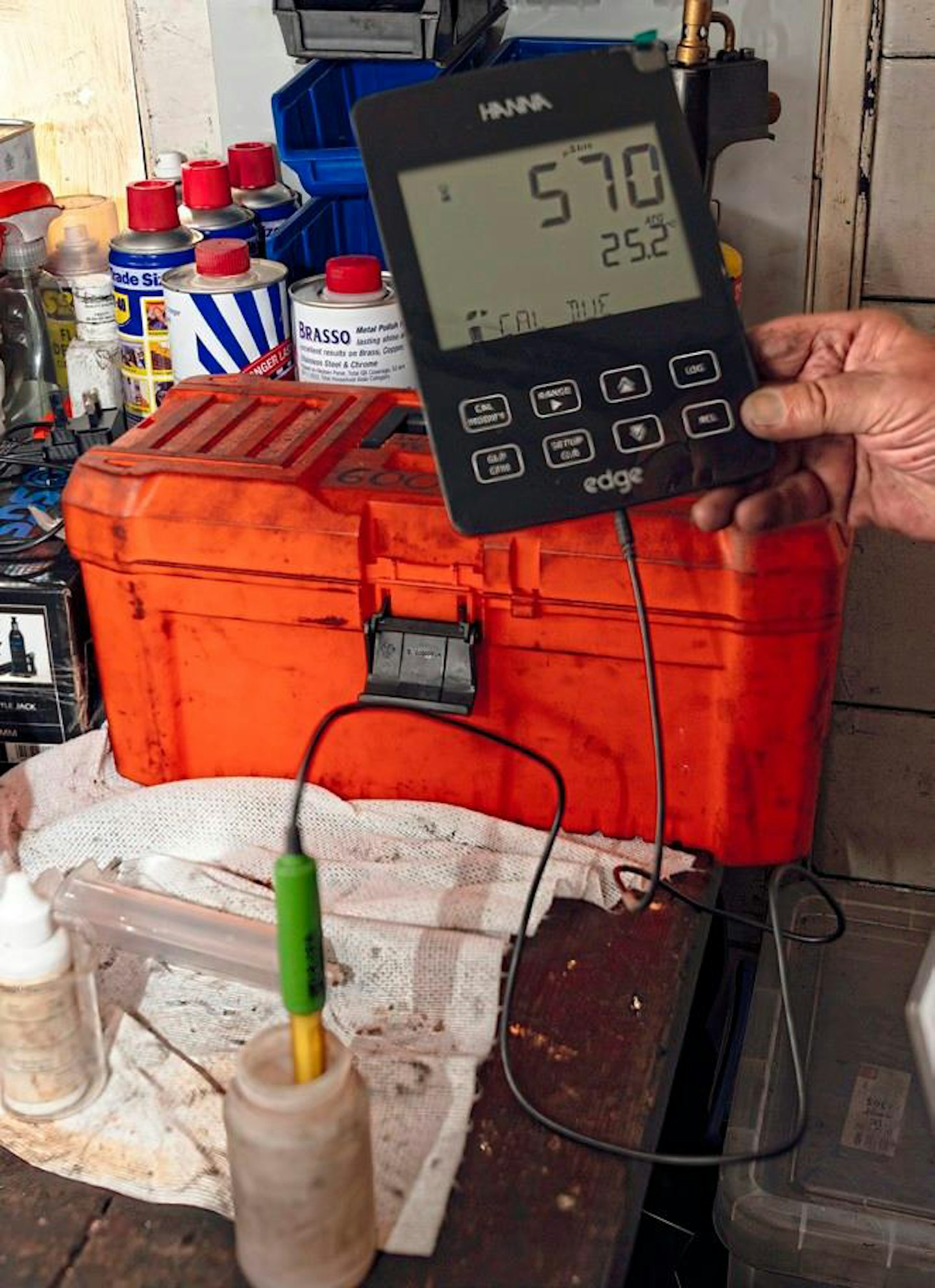
Conducting a water analysis test.
Clean and unclean
The move from the NRM’s workshops in York to complete No. 60007’s overhaul at LSL in Crewe was brought about by Covid-19 delaying the overhaul and the NRM’s own redevelopment plans. The Sir Nigel Gresley Locomotive Trust was incredibly grateful for the LSL gesture offering its facilities to complete the overhaul, which gave the opportunity for the teams to work together and familiarise themselves with each other before the return to traffic in 2022.
A new learning curve evolved as the operations from a main line depot on busy main lines is vastly different from the operations on a heritage railway line. One of the key issues was volunteer availability, as with most of the team based in North-East England, overnight, two-day or longer visits became the norm instead of the usual oneday visits to Grosmont. The Crewe base eventually attracted some new volunteers who lived nearer and could do the usual one-day visits. However, the new North Yorkshire base will require teams at both locations, initially working on Sir Nigel Gresley at Crewe and Bittern in North Yorkshire.
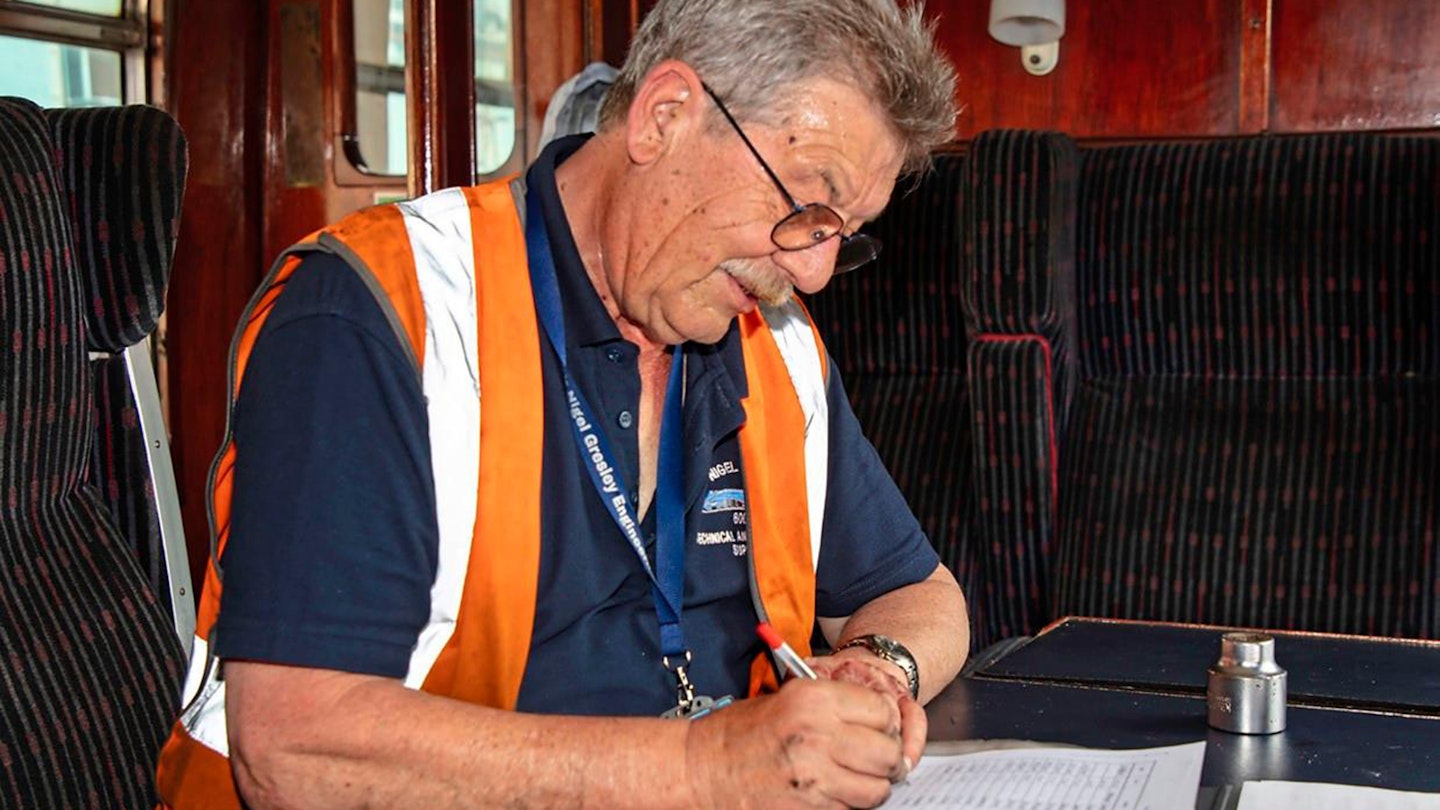
Nigel Hoskison writes up his water analysis reports.
Since ‘SNG’ came back into traffic in 2022 after overhaul, she has been working a mix of main line and heritage railways, recently returning to LSL at Crewe from a very successful few weeks on the NYMR. The stay on the NYMR was very well supported by the NYMR team and the trust’s own volunteers. The return to Crewe was delayed due to unseasonal dry weather, creating a lineside fire risk and affecting steam train operations. Ultimately, this led to a return journey in light steam coupled with an LSL Class 37 diesel providing the main power.
A few days later, I also went back to Crewe where Darrin requested that I observe additional behind-the-scenes work. Phil Gillespie had been assigned the task of cleaning out the smokebox ashes and Nigel Hoskison walked me through the technical water testing process. Two opposite ends of the cleanliness scale; I was incredibly protective towards my camera and lens from the gritty ashes of the smokebox cleaning, while the water analysis and treatment had to be done in a far cleaner environment. Nigel explains that he carries out three tests which are all aimed at preserving the working life of the boiler by reducing as much as possible the effects of corrosion and contamination. Tests are carried out not only from the water in the boiler but the water in the tender, as the water characteristics change from area to area. The three tests are a pH test and treatment, which is carried out to minimise acidic corrosion; TDS (Total Dissolved Solids) and treatment to reduce ‘priming’ (foaming), which left untreated reduces the steam-making capability of the boiler; and a tannin test and treatment to control dissolved oxygen thus reducing the effects of corrosion.
Darrin then took me down into the pit below ‘Gresley’ where, armed with an oil can, he disappeared up between the main drive wheels to lubricate a small end, and I tried valiantly to follow with my camera without a great deal of success. Darrin had planned to carry out work involving the removal of the connecting rods today, but that would have to wait due to availability of volunteers on the day. Nonetheless, the day gave me a good insight into the behindthescenes maintenance requirements of operational working compared to my many previous days documenting the work during the overhaul in my book, The Overhaul Picture. The work at Crewe will now continue at a pace as the new season of main line trips fast approaches – Darrin estimates that for every hour running, there is 100 hours of maintenance and preparation.
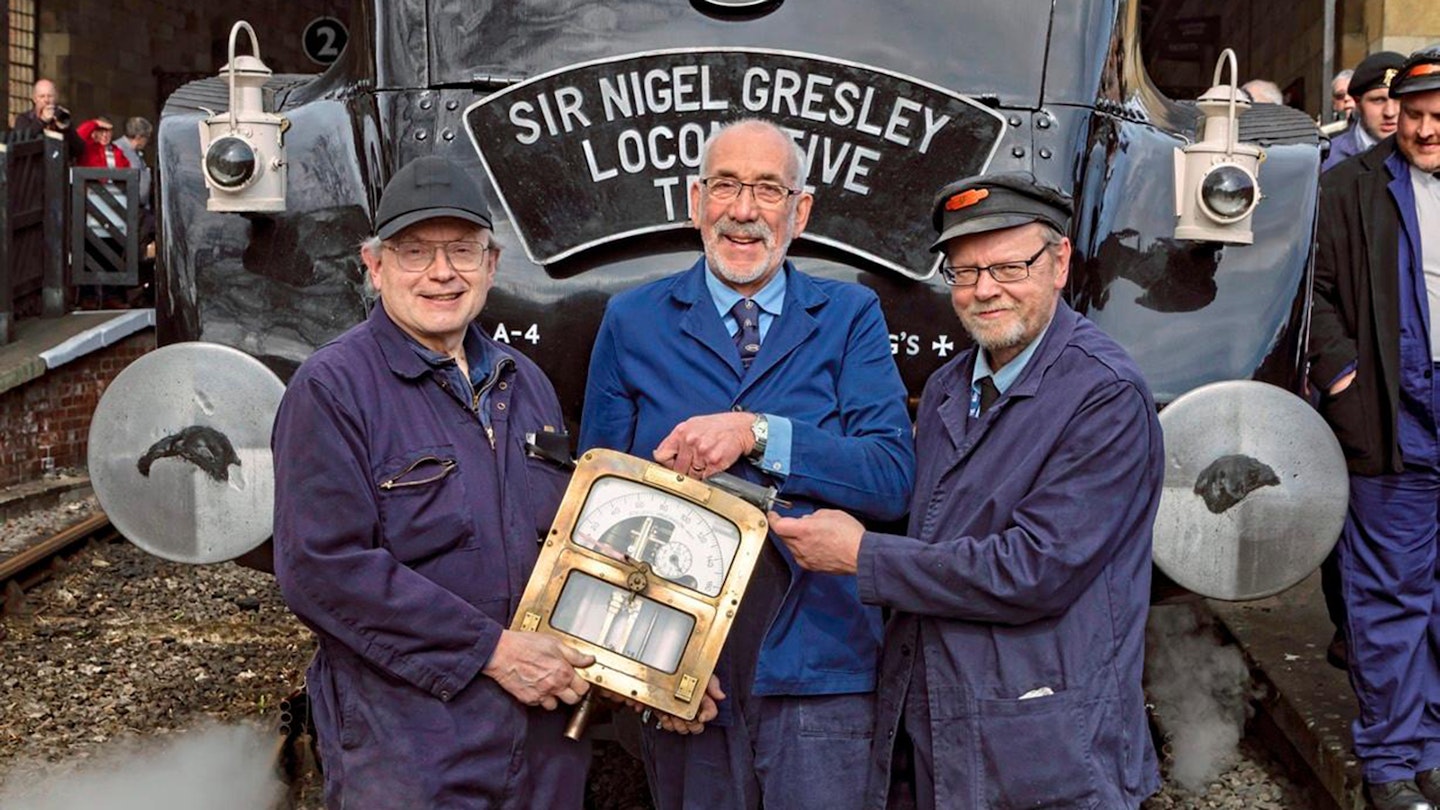
Ian Foot (centre) presents SNGLT CME Richard Swales (left) and Darrin Crone (right) with a genuine ex-SNCF Flaman speed recorder during a ceremony at Pickering on March 27.
Authenticity first
The mix of main line and heritage railway work averages 40 days a year, constituting a little over 10% of a year. Not a lot, you may think, but that does not tell the full story. You need to factor in all of the maintenance and tasks to be undertaken by the small team of Darrin and his volunteers compared to the large teams that British Railways and the LNER had available, and the fact that the locomotive is nearly 90 years old and far more complex than when built, with the addition of modern equipment such as On-Train Monitoring and Recording (OTMR) and the air system adding to the tasks.
There is pressure for even more additions, but the trust wants to maintain authenticity. For example, the aforementioned air system is only for coach braking; the locomotive itself is still authentically vacuum-braked, and there are also plans to refit a recently acquired Flaman speed recorder which was in use prior to the Smith’s speedometer in 1959.
The requirement for more advanced technology for main line operations will, inevitably, increase. This will strain the trust’s policy of staying as authentic as possible and will create a tipping point of whether to relax the policy and allow more technology in order to stay main line compatible, or stay authentic and only run on heritage railways which do not require all the higher levels of technology. There is currently a nice balance between main line and heritage running, but there will no doubt be decisions to be made and bridges to cross further down the line (pardon the puns). But for now, if you want to ride behind a main line steam locomotive on a main line you should, as Darrin told me, “Make hay while you can, and do so sooner rather than later.”
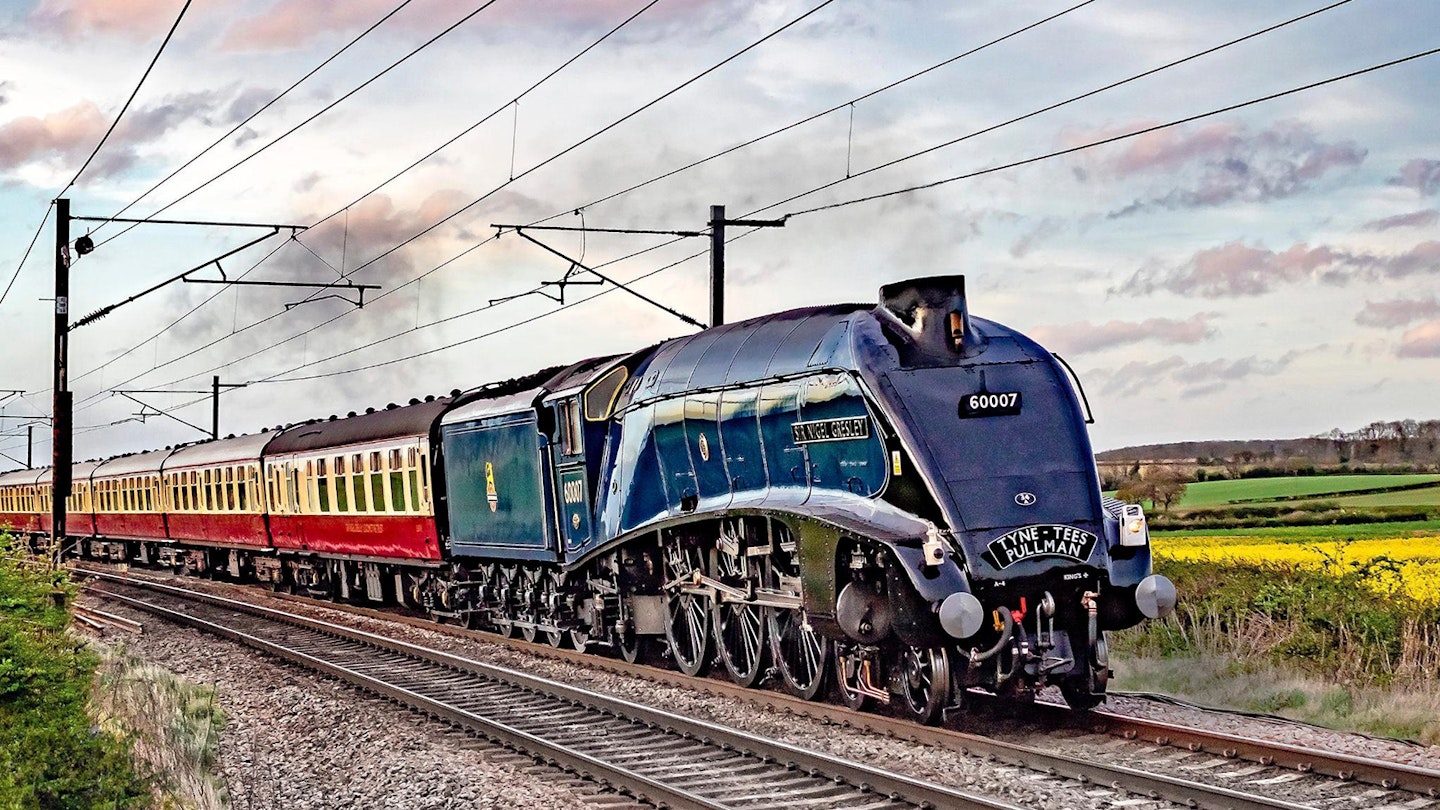
Sir Nigel Gresley in gleaming 1950s condition speeds north along the East Coast Main Line at Gamston Bank, south of Retford, with a recreation of the ‘Tyne-Tees Pullman’ on April 6 2024. ALAN WEAVER
Info
There is always room for more volunteers at both bases, so if you have the time and are interested in volunteering, or you are a suitably qualified engineer looking for a career-changing opportunity and feel you could meet the requirements of the full time Assistant Locomotive Engineer position, Darrin would be delighted to hear from you. Please contact Darrin at darrin.crone@sirnigelgresley.org.uk
Each issue of Steam Railway delivers a wealth of information that spans the past, present and future of our beloved railways. Featuring stunning photography, exclusive stories and expert analysis, Steam Railway is a collector's item for every railway enthusiast.
Choose the right subscription for you and get instant digital access to the latest issue.

